The term "sustainable seafood" can be interpreted in many different ways so for the purposes of this blog post, we want to define exactly what we mean when we say "sustainable seafood". Sustainable seafood refers to resposibly sourced seafood that is fished or farmed in ways that keeps ecosystems and oceans healthy, helps fisheries stay productive, and keeps fishing communities stable.
Browse through this whole post or click the links below to jump to the section about each particular producer.
- Fogo Island Fish
- Kolapore Springs
- Springhills Fish
- First Fish
- Gidney Fisheries
- Scout Canning
- Labrador Gem Seafood
At 100km Foods, we fully stand behind the practices of our seafood suppliers and their commitment to producing their seafood products responsibly and sustainably.
Sustainable seafood Supplier: Fogo Island Fish
Fogo Island Fish began as a small pilot project pioneered by Anthony (Tony) Cobb and his wife Janice Thomson.
In the 1960s, there was a devastating collapse of the cod fishery in Newfoundland. Smaller fishermen using traditional hook-and-line methods to catch their fish were being edged out of cod fishing by larger, technologically advanced vessels. Increasingly efficient technology allowed fishers to find and harvest unprecedented amounts of cod. At the same time, regulations safeguarding cod stocks did not evolve alongside the world's ability to harvest fish, and governments or international bodies sometimes assigned quotas based on economic factors rather than ecological ones. This industrial overfishing eventually led to the federal government placing a moratorium of the cod fishery in 1992 (Cod Moratorium - Newfoundland and Labrador Heritage).
The Fogo Island Co-operative Society, a community based enterprise of local fisher folk whose families have been fishing cod off the coast of Newfoundland for 500 years, was formed in response to this collapse of the cod fishery in Newfoundland, and talk of forced resettlement for the people of Fogo Island to urban centres on the mainland.
Tony’s own family had fished for cod in the waters off the coast of Fogo Island for 200 years. Tony’s father was one of the fishers who had to quit fishing in the 1960’s and start another career to support his family. Tony is one of the first in eight generations who is not a fisher.
A small stewardship fishery remains, but it’s still been difficult for local fishers to once again make a viable living catching cod.
This is why Tony and Janice wanted to use their understanding of the difficulties cod fishers face to start Fogo Island Fish, a stewardship fishery, in 2016.
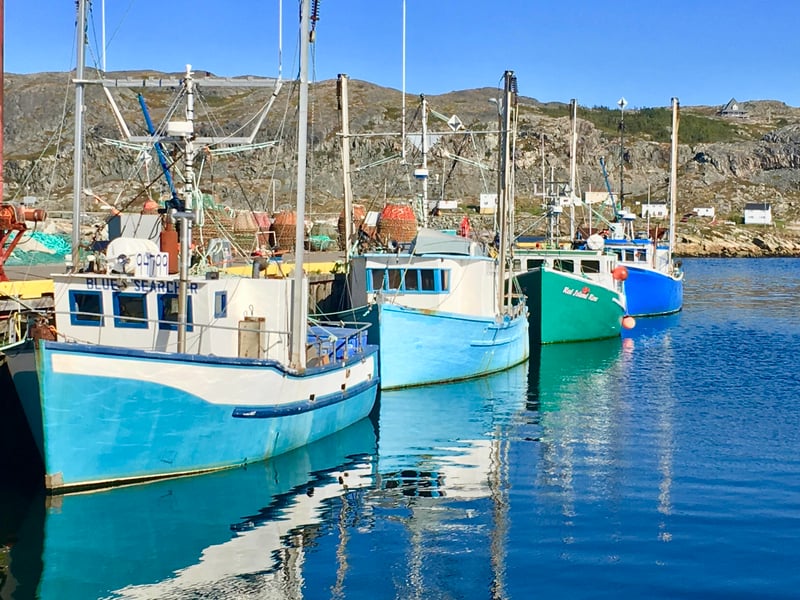
Ecosystem & Ocean Health
As a result of the moratorium on cod, the fishery in Newfoundland diversified from cod fishing to include species such as pink shrimp, snow crab, squid and turbot, allowing cod stocks to slowly recover. Fogo Island Fish sells these diversified products as well as ethically caught cod, harvested in day boats 5 miles off the shore of Fogo Island, 2 fishers per boat, one cod at a time. This traditional hand-lined method results in zero by-catch, no ecological damage to the ocean floor and allows fishers to adhere to strict catch quotas to help regenerate cod stocks.
Fogo Island Fishers only catch fish once a year, in the fall when the fish are at their physiological peak. This is because they can take 20-25% fewr fish from the ocean during this time as the cod have been gorging throughout the summer on bait fish to put on weight after spawning in the spring.
.png?width=641&height=647&name=Fogo%20Island%20Fish%20(1).png)
Productive Fisheries & Stable Communities
Fogo Island Fish is a Shorefast social business. Shorefast is a registered charity whose mission is to build cultural and economic resilience on Fogo Island and to serve other communities by sharing place-based models of economic development.
Shorefast’s social businesses (Fogo Island Inn, Fogo Island Fish, Fogo Island Workshops and Growlers Ice Cream) are designed to be economic engines for the community: they create meaningful employment, contribute to the local economy and generate income to be reinvested in the local through Shorefast’s charitable programs. These businesses are operated for the exclusive benefit of strengthening the cultural heritage, supporting ecological sustainability, and investing in the economic well-being of Fogo Island.
Fogo Island Fish pays its cod fishers higher compensation for their catch, and they work directly with the Fogo Island Co-operative Society to catch and process their fish.
Fogo Island Fish Product Offering & Catch Method
- Hand-Lined Cod: local fishers use the centuries old hand-line method to catch our cod, meaning there’s only ever one hook, one fish and zero bycatch.
- Northern Pink Shrimp: local fishers go out in small inshore boats, and they bring back the last trawl of the day, to ensure the highest quality product for your table.
- North Short-Fin Squid: squid is caught by hand, or ‘jigged’ in the Fall. Many of the waters around Fogo Island are known as squid-jigging grounds.
- Snow Crab: Fogo's snow crab is harvested from May through early June each year by dayboat fishers. Processed within 24 hours of being caught.
- Turbot (temporarily out of stock): turbot is fished about 200km off the northern coast of Fogo Island, between Fogo and Greenland. It is caught in trawl nets, and bycatch is managed and returned to the ocean.
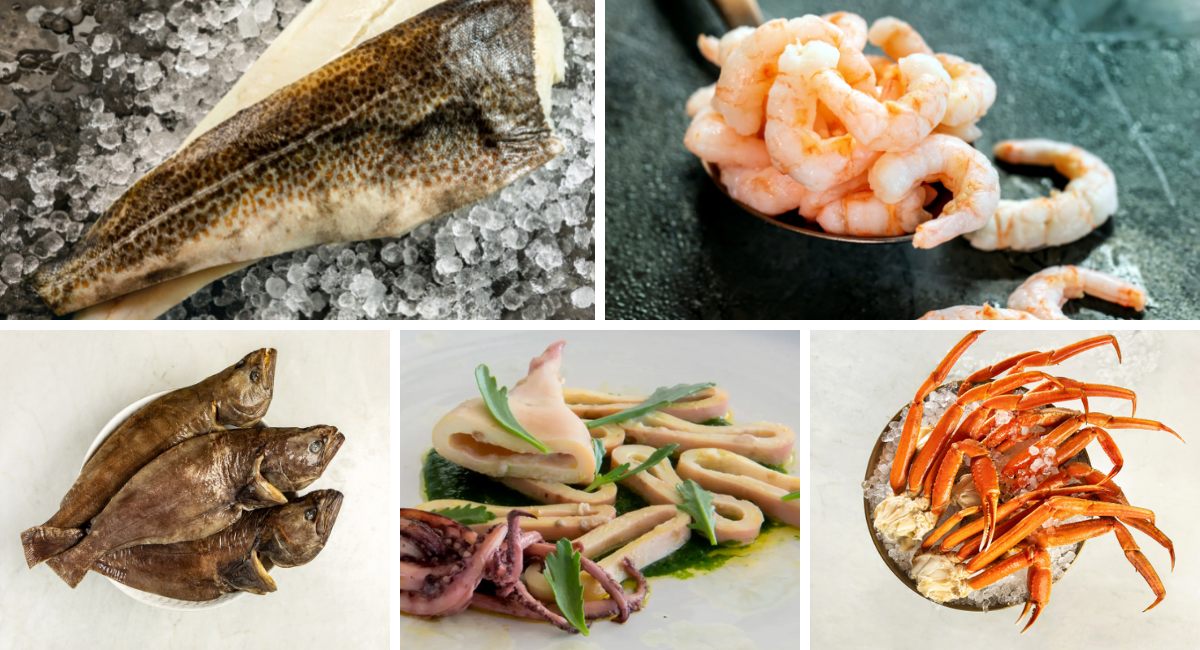
Certifications
- Fogo's cod, shrimp, and snow crab are Ocean Wise Recommended.
Sustainable seafood Supplier: Kolapore Springs
Kolapore Springs was founded by Sean Brady and Bruce Green in 2009. The Kolapore Springs Hatchery uses the flow from a natural spring to help fish spawn. The water moves through a series of dams and into the hatchery that was originally built in 1962.
The water filters down through limestone, and then travels below the forest floor, picking up minerals, enzymes and nutrients along the way.
Kolapore Spring's eggs are hatched in homemade trays and then moved to small troughs and then to large cement tanks, as they grow. Eventually, they move to the final spot in the raceway where they continue to grow until harvested.This process takes a little longer than (just over two years) due to the cooler water temperature from the Sprng than commercial fish farms.
Kolapore Springs Ontario rainbow trout feed on fairy shrimps (naturally found in the Spring and gives their flesh the signature pink hue), mosquitoes, midges and minnows. They are supplemented with a feed mix made up of plant protein (a combination of flax, soy and corn).
Because trout are naturally very slow growing fish, they aren't harvested until they reach around 3 years old. The larger fish are kept for spawing year after year to keep a sustainable operation going.
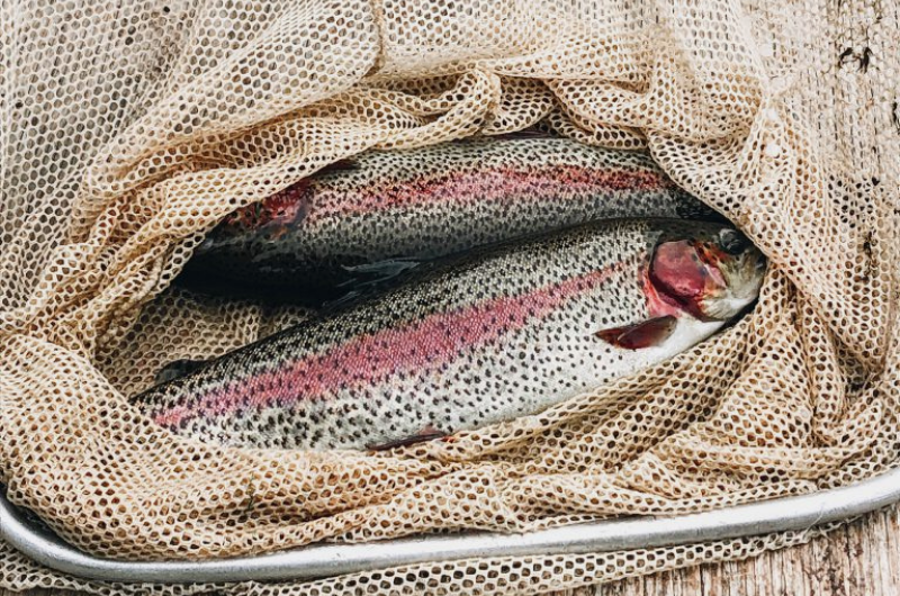
Kolapore Springs Product Offering & Catch Method
- Ontario Farmed Rainbow Trout Whole-Dressed: Sustainably Farmed at Kolapore Springs.
- Ontario Farmed Rainbow Trout Fillets: Sustainably Farmed at Kolapore Springs.
- Ontario Farmed Smoked Rainbow Trout Fillets: Sustainably Farmed at Kolapore Springs.
- Ontario Farmed Smoked Rainbow Trout Bits: Sustainably Farmed at Kolapore Springs.
Ecosystem Health
As a result of their premium diet, there's no need to use any kind of added growth hormones or antibiotics because the inland spring water is largely self-correcting. Gravity does most of the work to keep the water properly oxygenated to prevent bacteria growth! They also use sponges to collect debris from storm water.
The Kolapore Springs hatchery produces very little waste. They even collect and harvest the excrement to use as fertilizer.
Partnership With Fisherfolk & Expanded Product Offering
Kolapore Spring has teamed up with Fisherfolk to grow their frozen vac-packed fish offering. With so much competition to do everything cheaper, there is unsurmountable pressure on fisheries to offload costs in ways that sacrifice product, people and heritage. Fisherfolk through the quality fish they source and offer, are dedicated to helping keep self-sustaining, proud fisher folk doing what they love for generations to come.
Through Kolapore's partnership with Fisherfolk, we also offer the following products:
- Black Cod: Black Cod, also known as sablefish or butterfish, has a high fat content making it buttery and soft. This black cod is wild caught using long-line fishing techniques off the west side of Haida Gwaii British Columbia.
- Tuna: Sushi-grade, and lean but firm in texture. Wild caught off the east coast of Nova Scotia twice a year when tuna are migrating through the east coast.
- Haddock: Lean, mild and sweet, this Haddock is wild caught using long line fishing techniques year-round in Nova Scotia off the Scotian Shelf.
- Arctic Char: Wild caught in Baffin Island (Rankin Inlet, Nunavut) using traditional Indigenous techniques by indigenous owned and operated fisheries twice a year during winter harvest and summer harvest.
Certifications
Kolapore Spring's Ontario rainbow trout products are all Ocean Wise Recommended.
Sustainable seafood Supplier: Springhill's Fish
Springhill's Fish is a second-generation fish farming business in Ontario that raises rainbow trout, coho salmon, and Arctic char at several farms in Grey County. This small-scale farm puts a lot of emphasis on ethical and humane growing methods to ensure that the way they farm their fish has the fish, the planet and the community top of mind.
Siblings Arlen and RJ now run the family business. Arlen is motivated by the animals and fish health, her husband Mike by building and tinkering, and RJ by getting to grow and talk about sustainable food. They have an incredible team of 24 staff, many of which are married or related, that work hard and play hard with them!
Springhills raises rainbow trout, Arctic char and coho salmon at their small land-based farms in Grey County.
The amazing thing about Springhills raising the fish themselves is the level of control they have over virtually everything in the production process, which means they can ensure a consistent quality and great taste of their products.
They control the water quality, what the fish eat, how they live and are handled, and just as importantly, how they’re humanely harvested.
They take special care for animal welfare (Arlen actually helped write Canada’s farmed fish welfare code!) which includes lower densities, plenty of fresh water, and they even offer enrichment like water sprayers that calm and exercise their fish.
Ecosystem Health
Springhills is the only land-based farm in central Canada that is eco-certified by Best Aquaculture Practices (BAP). It took them four years to prepare for their first audit two years ago. The program is voluntary and much stricter than our government requirements, but Springhill does it to show their customers that they hold themselves to the highest international standard for sustainability. Part of being BAP-certified also means that they can only use special fish feed from BAP-certified mills, which is just another reason Springhills fish are good for you, and good for the planet!
A few studies from Lakehead University and the University of Guelph have suggested that inputs from fish farms around Lake Huron could have a positive effect on local fish communities. Learn more about this in Springhill's blog post on the environmental imapact of their fish farm.
Springhill's Product Offering & Catch Method
- Rainbow Trout: Mild nut-like flavour similar to salmon. Raised on Springhills family eco-farms in Grey County with plenty of fresh water, low densities and sustainable diets.
- Arctic Char: Lighter and sweeter flavour than it’s cousins, trout and salmon. Grows in colder water giving it a thick skin perfect for barbecuing or frying. Raised on Springhills family eco-farms in Grey County with plenty of fresh water, low densities and sustainable diets.
- Pickerel: Light succulent flavour with a flaky texture. One of the most sought after freshwater fish in North America. Caught by independent fishermen and women in Lake Erie. A wild fishery recognized as sustainable by the Marine Stewardship Council, which means it’s good for the environment and safe to eat.
- Atlantic Salmon: Mild-flavoured with rich taste. Raised in Cape Breton, Nova Scotia by a land-based farm called Sustainable Blue. They raise fish in a similar manner to Springhills with plenty of fresh water, low densities and eco-diets.
- Coho Salmon: Farmed at Springhills, newly available!
- Atlantic Scallops: These scallops are sustainably sourced from the shores of Digby, Nova Scotia.
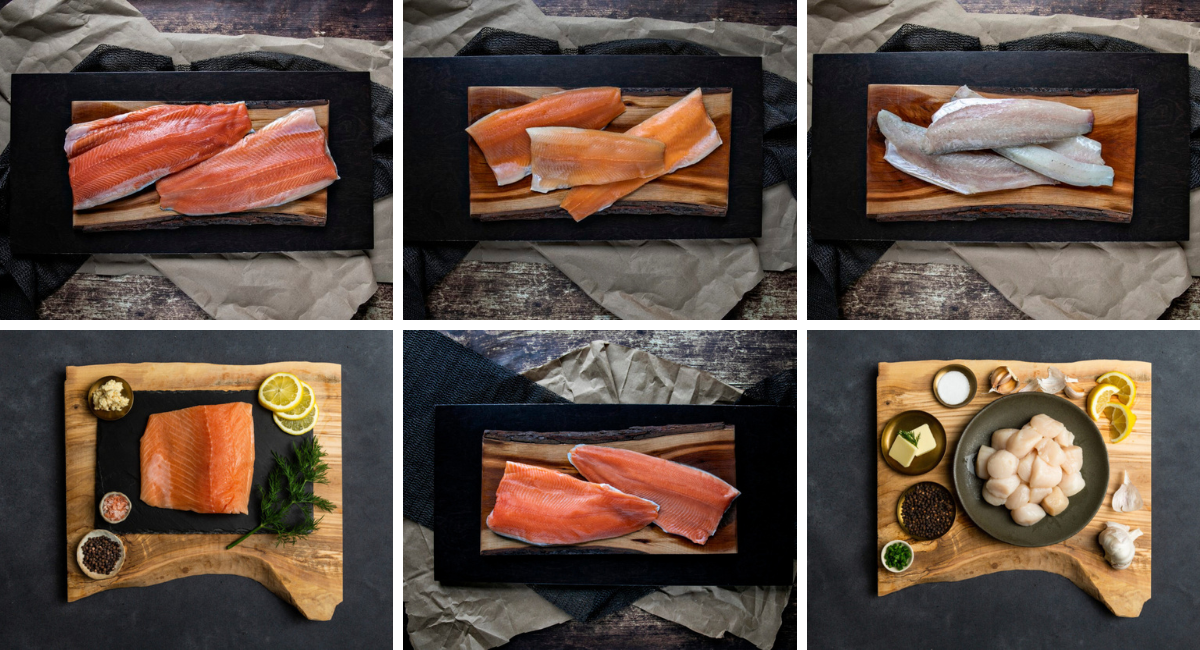
Certifications
- All Springhill's Fish products are Ocean Wise Recommended.
- Springhills is the only land-based farm in central Canada that is eco-certified by Best Aquaculture Practices (BAP).
Sustainable seafood Supplier: First Fish
All of First Fihs's Arctic Char and Turbot is wild caught off the coast of Baffin Island Nunavut, from the pristine waters of the Canadian Arctic. Inuit fishermen travel hundreds of kilometers across lakes in the mountains of Baffin Island to catch the Arctic Char and Turbot we source from First Fish. Using their traditional knowledge and skills they developed over thousands of years, they travel across the frozen lakes on snow machines and use only nets and long lines to catch the fish through up to 8 feet of ice, for minimal disturbance to the environment.
Ecosystem & Ocean Health
First Fish supports two quota systems to protect the sustainability of the northern lakes and oceans, the official quota set by the Department of Fisheries & Oceans and the local quotas set by the elders in the Indigenous communities.
Productive Fisheries & Stable Communities
First Fish Distribution is a Non-Profit Corporation that invests in building sustainable fisheries in remote communities. 100% of the product sales of First Fish products are re-invested into local Inuit communities to help support the growth of the fishery on Baffin Island through training, equipment, capacity building, and exploratory research.
The surplus can also be used for any other local activities that will benefit the communities such as arts and tourism developments.
First Fish Product Offering & Catch Method
- Arctic Char Fillets: wild caught by the Inuit fishermen of Rankin Inlet, off the coast Nunavut and Pangnirtung, just off the coast of Baffin Island.
- Hot Smoked Arctic Char: wild caught by the Inuit fishermen of Rankin Inlet, off the coast Nunavut and Pangnirtung, just off the coast of Baffin Island.
- Turbot Fillets: wild caught by the Inuit fishermen of Pangnirtung, just off the coast of Baffin Island, in Nunavut.
Certifications
- Due to its remote nature, it's hard to get inspectors up to Baffin Island for certification.
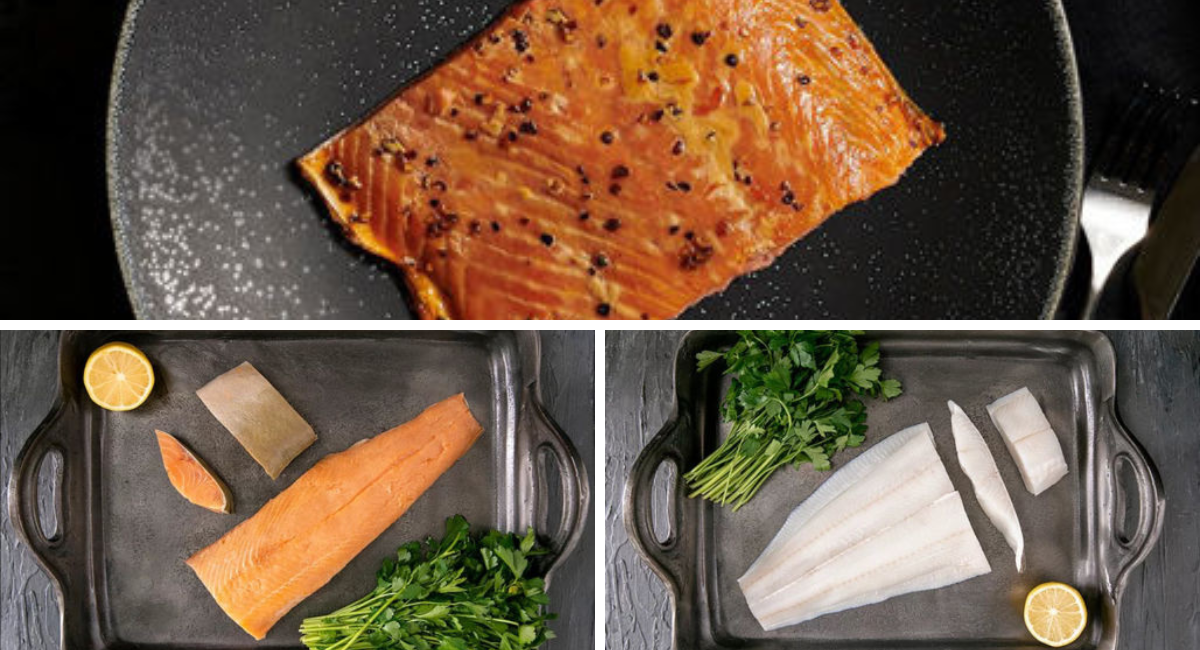
Sustainable seafood Supplier: Gidney Fisheries
Gidney Fisheries is a Canadian, family owned lobster business producing wild caught MSC Certified lobster through a family tradition of sustainability.
Gidney continues with the tradition of procuring, selecting, processing and delivering the finest quality lobsters harvested from the rich fishing grounds of the Bay of Fundy, Saint Mary's Bay and Southwestern Nova Scotia. They procure their lobsters from local fishermen. They have cultivated long-standing and trusted relationships with generations of lobster fishermen from the ports of Digby Neck.
Gidney grades these lobsters to meet the highest of standards, and humanely processes them in their technologically advanced storage facilities. Gidney uses HPP or High Pressure Processing to process their lobsters. This is a relatively new technology in the frozen lobster processing industry.
Their state of the art technology is based on a German High Pressure Processing machine, sometimes used to make cold-pressed juice, which creates pressure of up to 87,000 pounds per square inch. The machine compresses the lobster in its shell, breaking the connective tissue, killing the lobster in seconds and allowing the meat to be extracted entirely raw — a selling point for chefs and consumers, as the process is considered humane and improves meat yields.
The resulting lobster meat is completely raw, sushi grade product that is expertly extracted from the shell entirely intact. The raw lobster meat has had no heat applied and no additives to adulterate or change our finished product’s natural flavour.
Gidney Fisheries Product Offering & Catch Method
- Wild caught, raw, Nova Scotian MSC Certified lobster claw, knuckle and tail meat
- Raw Whole Lobsters Nova Scotian MSC Certified
.png?width=1200&height=650&name=First%20Fish%20(1).png)
Certifications
- Gidney Fisheries Lobster products are MSC Certified
Sustainable seafood Supplier: Scout Canning
Owned by PEI born chef, Charlotte Langely, Scout Canning makes deliciously crafted, responsibly sourced canned seafood products that celebrate the time-honored traditions of local fisheries and small scale canneries by modernizing the art of preserving and eating seafood.
Scout Canning Product Offering & Catch Method
- Albacore Tuna in Olive Oil: Scout sources its MSC-Certified albacore tuna from the Pacific between British Columbia and Oregon. These tuna are caught one at a time with one line, creating zero bycatch.
- Albacore Tuna in Pesto: Scout sources its MSC-Certified albacore tuna from the Pacific between British Columbia and Oregon. These tuna are caught one at a time with one line, creating zero bycatch.
- PEI Mussels in Tomato Sauce: Farming mussels are one of the most regenerative foods on the planet. They require no inputs which means no feed, no fertilizer and no additional water. These mussels are farmed in PEI.
- Atlantic Lobster: Scout sources their lobster right from the dock of their cannery in Prince Edward Island.
Certifications
- Scout is a fellow Certified B Corporation
- All Scout fish and seafood is MSC Certified
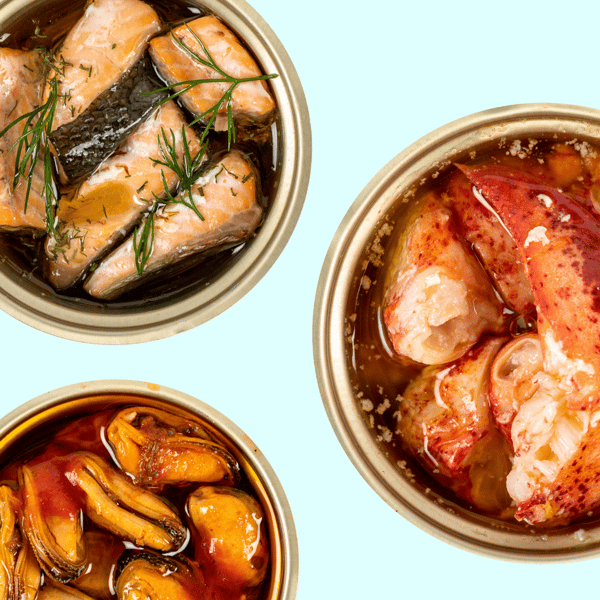
Sustainable seafood Supplier: LABRADOR GEM SEAFOOD
Located 10 miles off the Southwest coast of Newfoundland and Labrador, Ramea is a beautiful island community of 500 residents with a 200-year history of seafood processing that dates to the early days of flake-dried, salted cod.
The waters from which they harvest are some of the most prolific fishing grounds in the world. Swarming with life, the local varieties of shellfish, groundfish and pelagics make Ramea a choice location for sustainable and productive seafood processing.
Ramea used to have one of the largest cod fisheries in Newfoundland but after the cod moratorium in 1992, it almost shut down completely and the town came close to collapsing. But then Danny, the owner and operator, came in, took the plant over and started focusing on sustainable and unique seafood offerings like their half-shell scallop, to replace their cod business.
This is a small operation that is growing bit by bit as their story is becoming better known. And in a classic Canadian Seafood story, he sells a majority of his catch to Europe and USA and very little to Canada. We want to help change this.
Productive Fisheries & Stable Communities
Completely inaccessible by road, their unique cultural and geographical placement is a source of local pride. Labrador Gem Seafoods is committed to preserving their island ways of life. The community of Ramea is at the heart of what they do. They want to contribute to the sustainability of Ramea, and of Newfoundland and Labrador.
Labrador Gem Seafoods is determined to keep this speical production of multispecies seafood products working to preserve the place and its people. Home to a 10,000 square foot secondary fish processing facility, the Town of Ramea has a strong history of seafood production, and the market for the company’s high quality seafood product creates much needed, long-term employment for the area.
All Labrador Gem Seafoods are harvested sustainably and the application of value-added production ensures the sustainability of the community.
Labrador Gem Seafoods Product Offering & Catch Method
- Half-Shell Scallops: These scallops are wild harvested by dredge in the crisp clear waters of Newfoundland & Labrador, then hand-cleaned in pure seawater.
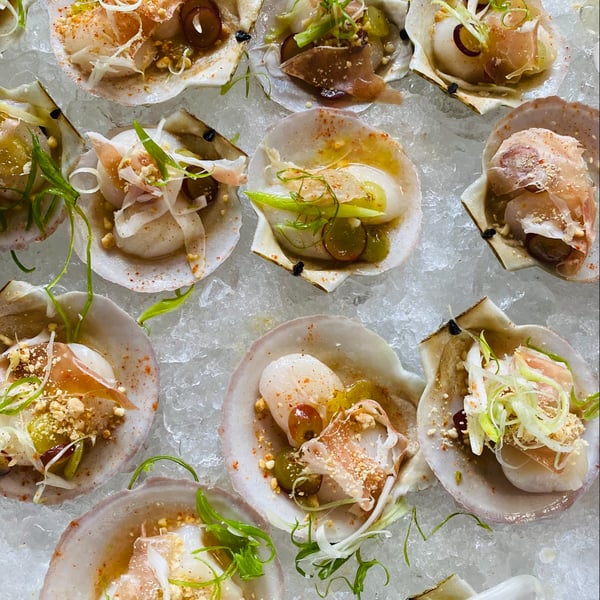
Certifications
- Labrador Gem Seafoods Half Shell Scallops are Ocean Wise Recommended.
- Safe Foods Canada Certified
Try Our Canadian Sustainable Seafood In Your Kitchens
Interested in trying any of the sustainable seafood offerings mentioned in this post in your restaurant kitchens? Let us know by reaching out to info@100kmfoods.com and we'd be happy to assist you.


